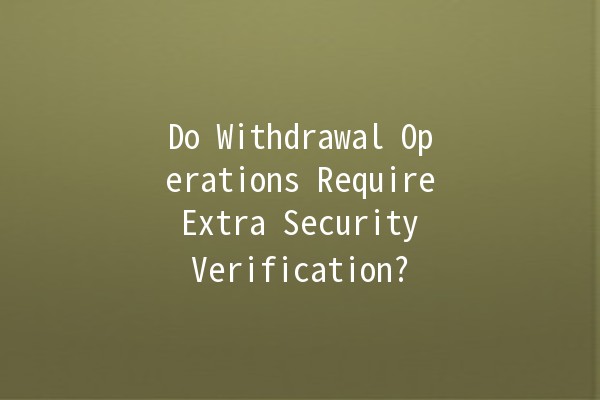
In the world of digital assets and cryptocurrencies, security is paramount. As users increasingly engage in withdrawal operations, the question arises: is extra security verification necessary? This article dives deep into the nuances surrounding security measures during crypto transactions, exploring why additional verification could be vital for safeguarding your funds and assets.
Understanding Withdrawal Operations

Withdrawal operations in cryptocurrency involve transferring assets from an exchange or wallet to another account or wallet. This process usually requires verification of the user's identity to prevent fraud and theft. While significant security measures are often in place, understanding the full extent of what extra verification entails is crucial.
The Importance of Extra Security Verification
Why Consider Additional Security Measures?
Types of Extra Security Verification
TwoFactor Authentication (2FA)
2FA adds an additional layer of security by requiring not just a password but also a second method of verification, typically a code sent to a user's mobile device. This can be particularly effective in preventing unauthorized access.
Example: When a user attempts to withdraw funds, they receive a text message with a verification code. The withdrawal only proceeds once the user enters this code.
Email Confirmation for Withdrawals
Many exchanges implement email confirmations as a safeguard. Users receive an email notification every time a withdrawal is initiated, requiring them to confirm the transaction.
Example: If a user requests a withdrawal, they receive an email with a confirmation link that must be clicked within a set time frame to approve the transaction.
Withdrawal Whitelists
Some platforms allow users to set up withdrawal whitelists, adding an extra layer of security. Only specified wallet addresses can receive funds, minimizing the risk of sending assets to unauthorized addresses.
Example: A user adds their personal wallet address to a whitelist. Any withdrawal attempt to other addresses is automatically blocked.
The Balance Between Security and User Experience
While extra security measures are essential, they can also complicate user experience. It's important for platforms to strike a balance between robust security and userfriendly operations. Solutions that enhance security while minimizing disruption to the user experience are ideal.
Practical Tips for Enhancing Withdrawal Security
Frequently Asked Questions
TwoFactor Authentication (2FA) is a security measure that requires users to provide two different authentication factors to verify their identity. This typically includes something you know (like a password) and something you have (like a mobile device).
Verifying your email after a withdrawal request is an additional security step to ensure that you are the one making the transaction. It helps to prevent fraudulent withdrawals initiated by someone who has gained unauthorized access to your account.
A withdrawal whitelist is a security feature that allows users to specify certain addresses to which withdrawals can be made. If a withdrawal request is made to an address not on the whitelist, it will be denied.
Absolutely. While these measures may seem cumbersome at times, the security they provide can safeguard your assets from theft and unauthorized transactions, ultimately saving you from more significant headaches.
Ideally, you should change your passwords every three to six months. Additionally, always update your password after any suspicious activity.
If you suspect that your account has been compromised, immediately change your password and enable 2FA if not already active. Notify the service provider to freeze your account and monitor any transactions for unauthorized activity.
al Thoughts
Navigating the world of cryptocurrency requires a solid understanding of security measures, especially regarding withdrawal operations. By embracing extra security verifications, you can greatly enhance the protection of your digital assets. The evolution of security in the crypto landscape is ongoing, and adapting to these changes will ensure your investments remain safe and secure. Stay informed, stay secure, and always prioritize your digital safety.

